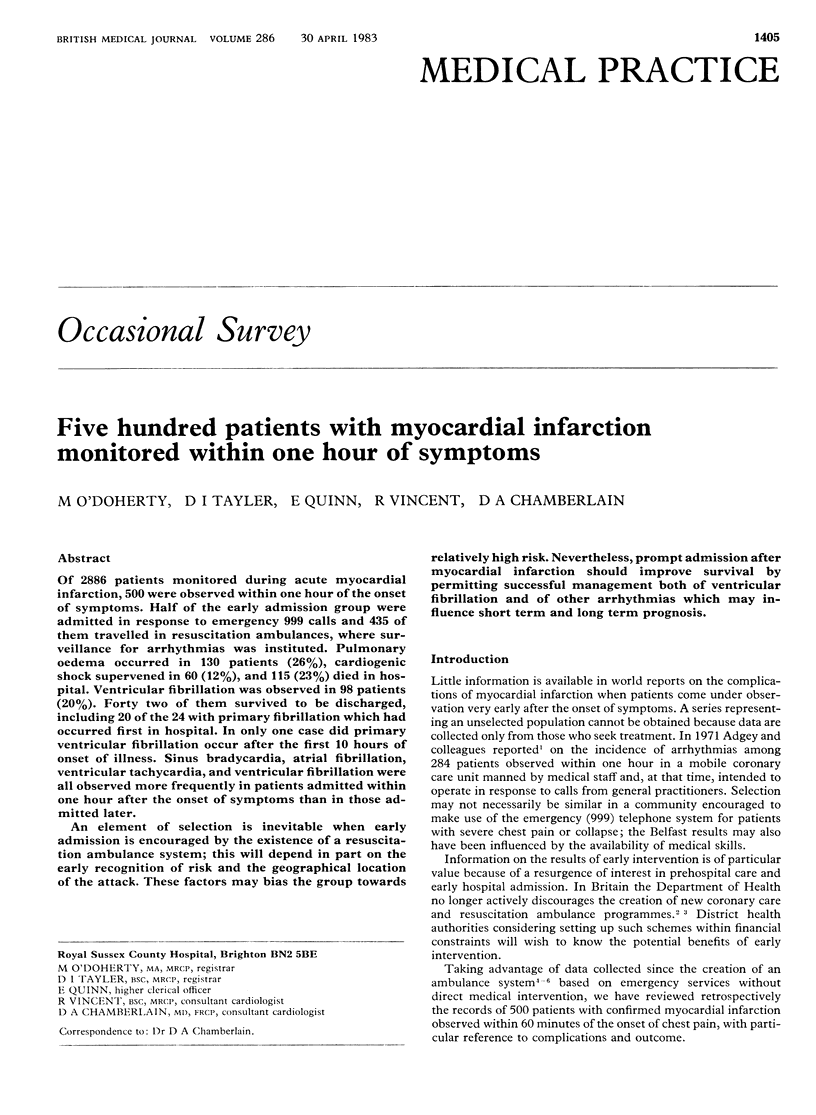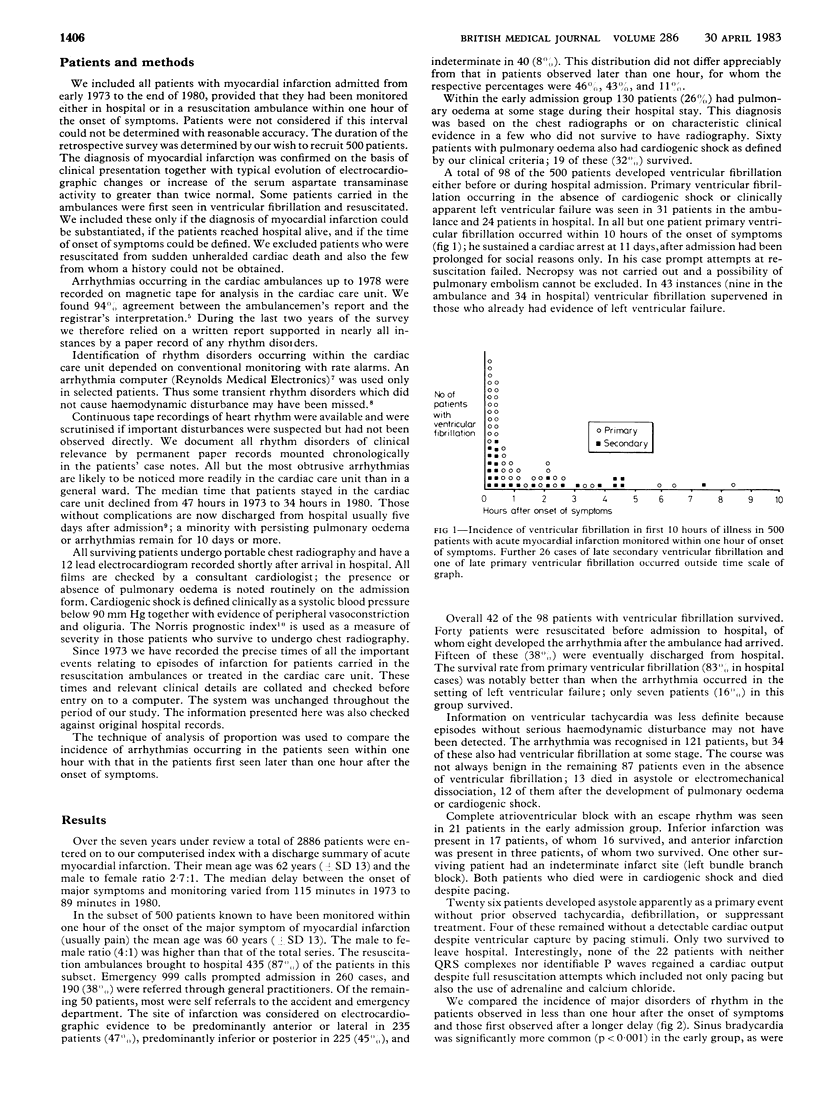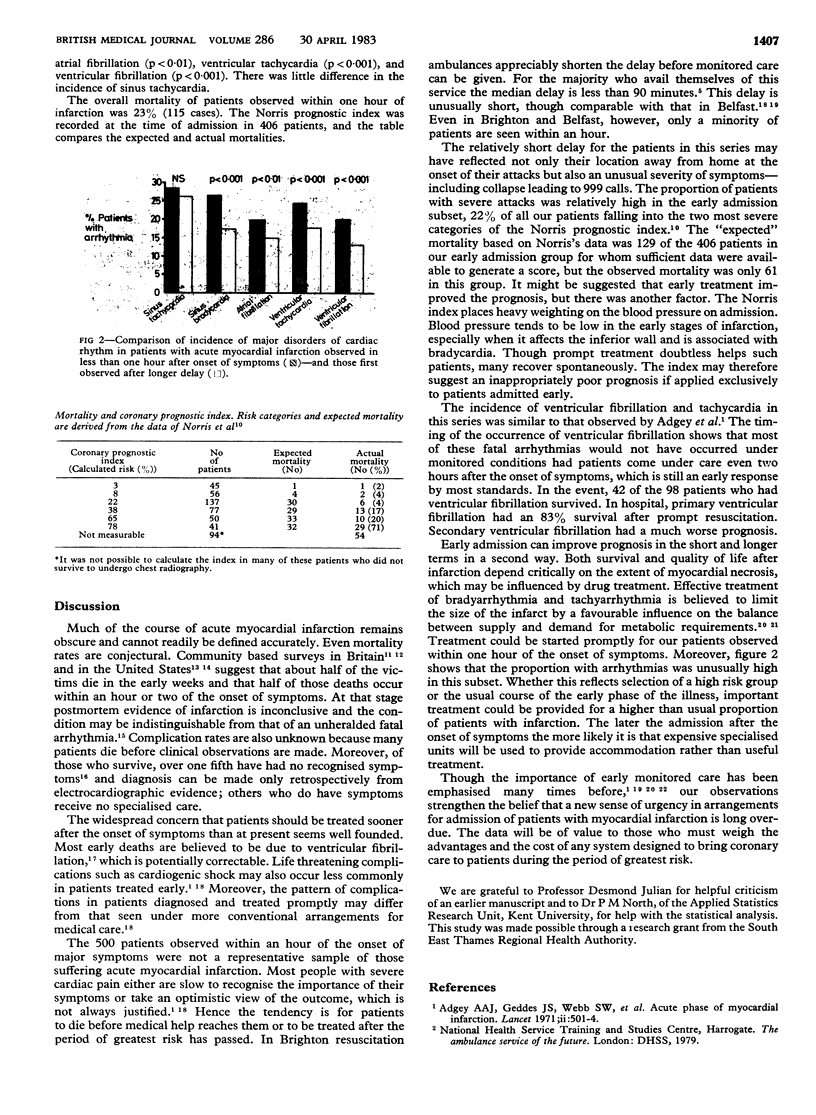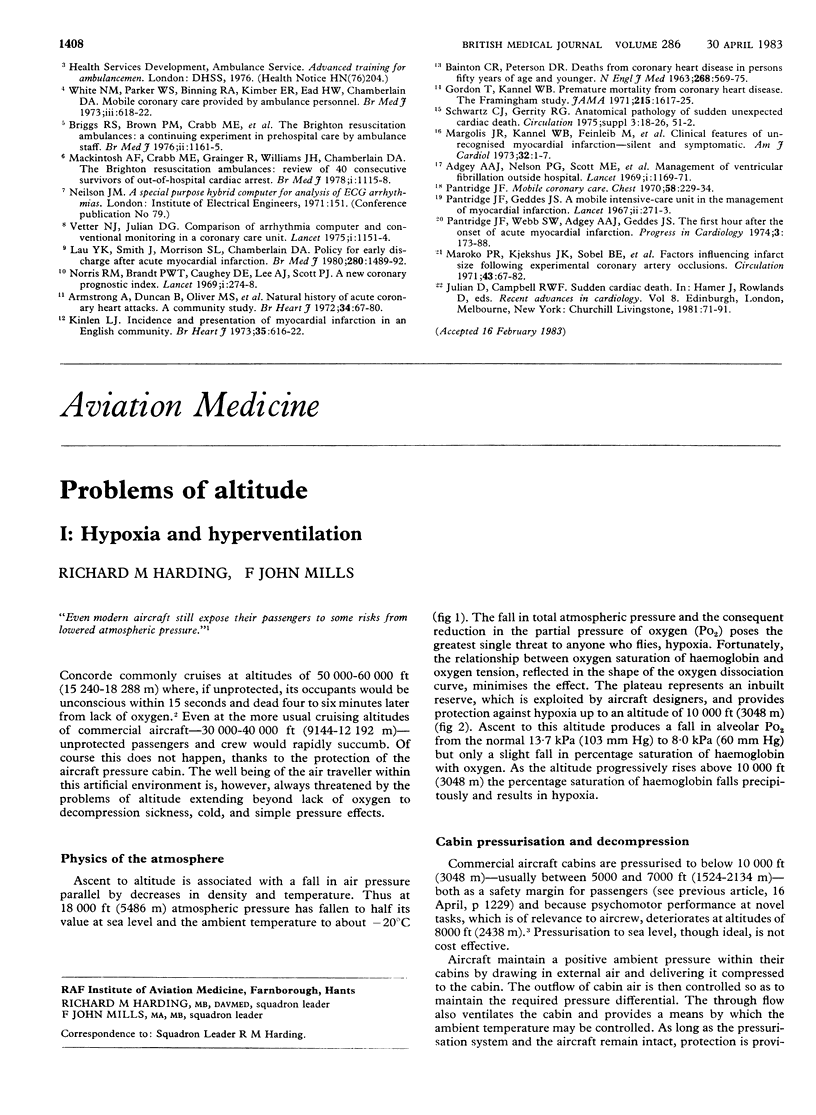Abstract
Of 2886 patients monitored during acute myocardial infarction, 500 were observed within one hour of the onset of symptoms. Half of the early admission group were admitted in response to emergency 999 calls and 435 of them travelled in resuscitation ambulances, where surveillance for arrhythmias was instituted. Pulmonary oedema occurred in 130 patients (26%), cardiogenic shock supervened in 60 (12%), and 115 (23%) died in hospital. Ventricular fibrillation was observed in 98 patients (20%). Forty two of them survived to be discharged, including 20 of the 24 with primary fibrillation which had occurred first in hospital. In only one case did primary ventricular fibrillation occur after the first 10 hours of onset of illness. Sinus bradycardia, atrial fibrillation, ventricular tachycardia, and ventricular fibrillation were all observed more frequently in patients admitted within one hour after the onset of symptoms than in those admitted later. An element of selection is inevitable when early admission is encouraged by the existence of a resuscitation ambulance system; this will depend in part on the early recognition of risk and the geographical location of the attack. These factors may bias the group towards relatively high risk. Nevertheless, prompt admission after myocardial infarction should improve survival by permitting successful management both of ventricular fibrillation and of other arrhythmias which may influence short term and long term prognosis.
Full text
PDF



Selected References
These references are in PubMed. This may not be the complete list of references from this article.
- Adgey A. A., Allen J. D., Geddes J. S., James R. G., Webb S. W., Zaidi S. A., Pantridge J. F. Acute phase of myocardial infarction. Lancet. 1971 Sep 4;2(7723):501–504. doi: 10.1016/s0140-6736(71)90434-x. [DOI] [PubMed] [Google Scholar]
- Adgey A. A., Scott M. E., Allen J. D., Nelson P. G., Geddes J. S., Zaidi S. A. Management of ventricular fibrillation outside hospital. Lancet. 1969 Jun 14;1(7607):1169–1171. doi: 10.1016/s0140-6736(69)92161-8. [DOI] [PubMed] [Google Scholar]
- Armstrong A., Duncan B., Oliver M. F., Julian D. G., Donald K. W., Fulton M., Lutz W., Morrison S. L. Natural history of acute coronary heart attacks. A community study. Br Heart J. 1972 Jan;34(1):67–80. doi: 10.1136/hrt.34.1.67. [DOI] [PMC free article] [PubMed] [Google Scholar]
- BAINTON C. R., PETERSON D. R. Deaths from coronary heart disease in persons fifty years of age and younger. A community-wide study. N Engl J Med. 1963 Mar 14;268:569–575. doi: 10.1056/NEJM196303142681102. [DOI] [PubMed] [Google Scholar]
- Gordon T., Kannel W. B. Premature mortality from coronary heart disease. The Framingham study. JAMA. 1971 Mar 8;215(10):1617–1625. [PubMed] [Google Scholar]
- Kinlen L. J. Incidence and presentation of myocardial infarction in an English community. Br Heart J. 1973 Jun;35(6):616–622. doi: 10.1136/hrt.35.6.616. [DOI] [PMC free article] [PubMed] [Google Scholar]
- Lau Y. K., Smith J., Morrison S. L., Chamberlain D. A. Policy for early discharge after acute myocardial infarction. Br Med J. 1980 Jun 21;280(6230):1489–1492. doi: 10.1136/bmj.280.6230.1489. [DOI] [PMC free article] [PubMed] [Google Scholar]
- Mackintoch A. F., Crabb M. E., Granger R., Williams J. H., Chamberlain D. A. The Brighton resuscitation ambulances: review of 40 consecutive survivors of out-of-hospital cardiac arrest. Br Med J. 1978 Apr 29;1(6120):1115–1118. doi: 10.1136/bmj.1.6120.1115. [DOI] [PMC free article] [PubMed] [Google Scholar]
- Margolis J. R., Kannel W. S., Feinleib M., Dawber T. R., McNamara P. M. Clinical features of unrecognized myocardial infarction--silent and symptomatic. Eighteen year follow-up: the Framingham study. Am J Cardiol. 1973 Jul;32(1):1–7. doi: 10.1016/s0002-9149(73)80079-7. [DOI] [PubMed] [Google Scholar]
- Maroko P. R., Kjekshus J. K., Sobel B. E., Watanabe T., Covell J. W., Ross J., Jr, Braunwald E. Factors influencing infarct size following experimental coronary artery occlusions. Circulation. 1971 Jan;43(1):67–82. doi: 10.1161/01.cir.43.1.67. [DOI] [PubMed] [Google Scholar]
- Norris R. M., Brandt P. W., Caughey D. E., Lee A. J., Scott P. J. A new coronary prognostic index. Lancet. 1969 Feb 8;1(7589):274–278. doi: 10.1016/s0140-6736(69)91035-6. [DOI] [PubMed] [Google Scholar]
- Pantridge J. F., Geddes J. S. A mobile intensive-care unit in the management of myocardial infarction. Lancet. 1967 Aug 5;2(7510):271–273. doi: 10.1016/s0140-6736(67)90110-9. [DOI] [PubMed] [Google Scholar]
- Pantridge J. F. Mobile coronary care. Chest. 1970 Sep;58(3):229–234. doi: 10.1378/chest.58.3.229. [DOI] [PubMed] [Google Scholar]
- Vetter N. J., Julian D. G. Comparison of arrhythmia computer and conventional monitoring in coronary-care unit. Lancet. 1975 May 24;1(7917):1151–1154. doi: 10.1016/s0140-6736(75)93134-7. [DOI] [PubMed] [Google Scholar]
- White N. M., Parker W. S., Binning R. A., Kimber E. R., Ead H. W., Chamberlain D. A. Mobile coronary care provided by ambulance personnel. Br Med J. 1973 Sep 22;3(5881):618–622. doi: 10.1136/bmj.3.5881.618. [DOI] [PMC free article] [PubMed] [Google Scholar]


